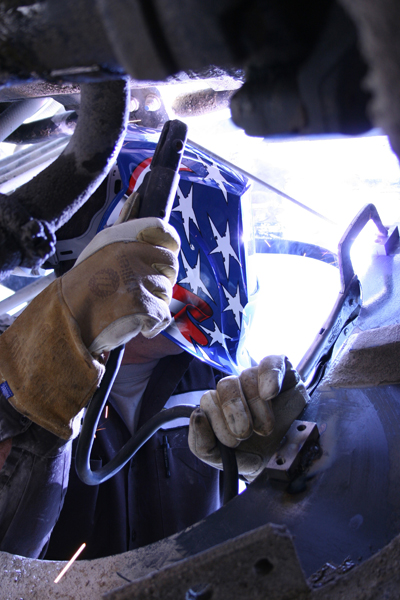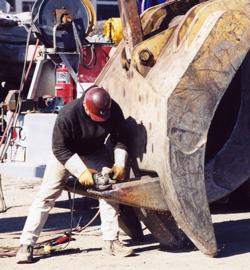All About Welding: Trick Insights Into Techniques and Ideal Practices for Success
Welding incorporates a variety of methods, each suited for details materials and applications. Understanding these methods, such as GMAW, SMAW, and TIG, is crucial for achieving excellent outcomes. Additionally, the appropriate equipment and security methods can not be ignored. As prep work and troubleshooting play critical functions in the welding process, grasping these aspects can considerably enhance the top quality of the last product. What are the crucial elements that guarantee a successful weld?
Recognizing Different Welding Strategies
Welding techniques incorporate a variety of techniques, each fit to details applications and materials. Amongst one of the most typical techniques are Gas Metal Arc Welding (GMAW), Shielded Metal Arc Welding (SMAW), and Tungsten Inert Gas Welding (TIG) GMAW, likewise called MIG welding, is prominent for its speed and convenience, making it excellent for slim materials. SMAW, or stick welding, is favored for its simpleness and performance in outside settings, particularly with thicker metals. TIG welding uses precision and control, making it suitable for elaborate work and non-ferrous metals (Montana Mobile Welding and Repair Fabrication). Each method has its unique advantages and considerations, permitting welders to pick the finest method based upon the project's requirements, material type, and desired outcomes. Comprehending these methods is crucial for effective welding
Essential Welding Devices and Tools
While various welding methods need certain skills, the ideal tools and tools are similarly important for accomplishing top quality outcomes. Vital welding devices consists of welding makers, which vary depending upon the strategy-- such as MIG, TIG, or stick welding. Safety gear, including aprons, handwear covers, and helmets, assurances security and comfort throughout the procedure. Additionally, components and clamps aid protect materials in location, guaranteeing precision in welds. Consumables like welding poles, cable, and protecting gas are also crucial components that influence the quality of the weld. Devices such as grinders and cutters promote surface area preparation and post-weld ending up, adding to an expert end result. Purchasing premium equipment ultimately boosts the effectiveness and performance of welding tasks.
Safety And Security Practices in Welding
Correct safety methods are necessary in the welding industry to secure workers from prospective hazards. Welders need to wear appropriate personal protective equipment (PPE), including safety helmets with proper shading, handwear covers, and flame-resistant apparel. Ample air flow is important to reduce exposure to hazardous fumes and gases created throughout the welding process. Furthermore, employees should be educated in the correct handling of welding equipment to avoid accidents. Fire safety measures, such as keeping combustible materials away from the welding location and having fire extinguishers conveniently available, are essential. Regular examinations of tools and work areas can assist determine possible dangers before they cause crashes. By adhering to these security methods, welders can develop a much safer working environment and reduce dangers related to their profession.
Readying Products for Welding
Preparing materials for welding is a vital step that substantially affects the high quality and stability of the last item (Belgrade Fabrication). Correct prep work entails cleaning up the surfaces to eliminate impurities such as rust, oil, and dirt, which can jeopardize the weld. Methods such as grinding, fining sand, or utilizing solvents are frequently employed to achieve a tidy surface. In addition, making sure that the products mesh comfortably is vital; voids can lead to weak welds. It's likewise vital to take into consideration the alignment and positioning of the elements, as this will affect the simplicity of welding and the final end result. Picking the proper filler product and ensuring compatibility with the base steels is necessary for attaining strong, sturdy welds.
Tips for Achieving High-Quality Welds
Attaining high-grade welds requires attention to detail and adherence to finest methods throughout the welding procedure. Proper joint preparation is crucial, making sure surface areas are totally free and clean from pollutants. Choosing the ideal filler material and welding strategy based upon the base steels is crucial for suitable bonding. Keeping consistent travel speed and angle while welding can stop problems and promote harmony. In addition, regulating warmth input is vital; extreme warm can bring about bending and weakened joints. If needed, consistently inspecting the welds throughout the procedure enables for instant modifications. Finally, utilizing suitable post-weld therapies, such as cleansing and stress and anxiety relief, can improve the sturdiness and stability of the weld, eventually making pop over here sure a successful end result.
Repairing Common Welding Issues
Welding frequently presents obstacles that can affect the top quality and stability of the end product. Common issues such as porosity, inconsistent weld welding skills beads, and getting too hot can occur, each calling for particular troubleshooting methods. Recognizing these issues is essential for welders to boost their skills and attain optimal outcomes.
Porosity Troubles Described
Although porosity can usually be forgotten, it continues to be an essential issue in welding that can endanger the stability of a finished item. Porosity describes the visibility of small gas pockets within the weld grain, which can compromise the joint and lead to premature failure. This issue usually emerges from pollutants, moisture, or inappropriate securing gas protection during the welding process. To alleviate porosity, welders should confirm that the base products are clean and dry, use ideal shielding gases, and keep constant welding specifications. Routinely checking the tools and atmosphere can additionally assist determine possible issues prior to they materialize in the weld. Resolving porosity effectively is crucial for achieving strong, sturdy welds that fulfill quality requirements.

Irregular Weld Beans
Inconsistent weld beads can significantly impact the top quality and strength of a completed product. Various aspects add to this problem, including inappropriate travel rate, incorrect amperage settings, and inconsistent electrode angles. When the welder relocates too promptly, a bead may appear slim and do not have penetration, while moving also gradually can create extreme buildup. Additionally, utilizing the incorrect amperage can lead to either undercutting or extreme spatter, both of which concession weld stability. The welder's strategy, such as inconsistent torch activity, can likewise result in unequal grain appearance. To reduce these troubles, welders must concentrate on preserving steady, controlled movements and guaranteeing appropriate devices settings to attain harmony in their welds. Uniformity is essential to attaining strong and reputable welds.
Overheating and Bending Issues
Extreme warm during the welding process can result in considerable overheating and deforming issues, impacting the structural integrity of the work go to this website surface. These issues often show up as distortion, which can compromise alignment and fit-up, making additional assembly testing. Elements adding to overheating include the selection of welding criteria, such as voltage and travel rate, along with the kind of material being bonded. To minimize these concerns, welders must keep regular travel speed and appropriate warmth input while keeping track of the workpiece temperature level. Additionally, pre-heating or post-weld warmth therapy can aid ease stress and anxieties triggered by quick cooling - Fabrication. Routine examination and adherence to ideal techniques are vital in avoiding getting too hot and making certain the longevity and reliability of bonded structures
Often Asked Questions
What Are the Career Opportunities in the Welding Sector?
The welding market offers diverse profession possibilities, consisting of placements as welders, instructors, inspectors, and engineers. Professionals can operate in manufacturing, building and construction, aerospace, and auto industries, taking advantage of solid demand and affordable salaries in different duties.
How Can I Boost My Welding Speed Without Compromising Top Quality?
To enhance welding speed without giving up top quality, one ought to practice reliable strategies, maintain devices, enhance settings, and improve hand-eye control. Routine training and seeking responses can additionally greatly add to attaining faster, top notch welds.
What Qualifications Are Available for Welders?
Many certifications exist for welders, consisting of those from the American Welding Culture (AWS), the National Center for Construction Education and Research Study (NCCER), and numerous industry-specific companies. These credentials improve employability and show skill proficiency.
How Does Welding Influence the Characteristics of Metals?
Welding influences the properties of metals by modifying their microstructure, which can cause modifications in ductility, strength, and firmness. Warmth input and air conditioning prices during the process significantly affect these material attributes.
Can I Weld Dissimilar Metals With Each Other?

Comments on “Tips for avoiding distortion in Montana Mobile Welding and Repair Welding projects”